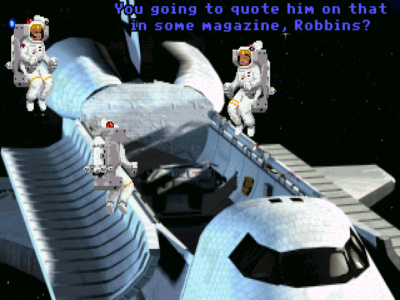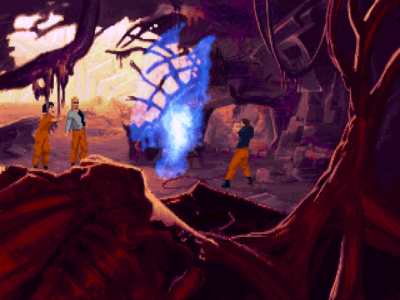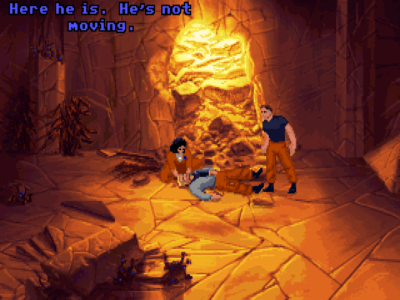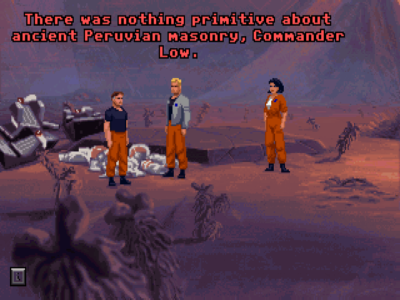
The Dig
Written by: Rik
Date posted: July 19, 2004
- Genre: Adventure
- Developed by: LucasArts
- Published by: LucasArts
- Year released: 1995
- Our score: 6
Eschewing traditions of wacky humour and cartoony graphics in favour of a more serious approach, The Dig was hindered by a long development process and was criticised on release for its dated look. Much delayed and largely ignored, it represents one of LucasArts’ less successful adventures. Some have since heralded it as an unfairly-ignored classic, however, and a recent re-release has provided the gaming world with an opportunity to take another look.
The story begins in the manner of Hollywood apocalypse movies such as Deep Impact and Armaggeddon: a huge asteroid is on a collision course with Earth, and the only way the situation can be resolved is by sending some Americans to blow it up a little with some nuclear weapons. Luckily, things take a turn for the more interesting when the team is mysteriously transported to a strange alien planet. You play Boston Low, straight-talking, all-American commander of the mission. Marooned with you are sarcastic journalist Maggie Robbins and seriously unhinged German archaeologist Ludger Brink. What will you find there? How will you get home? Will you even survive? Etc.

Wisecracking in space. The game gives constant (and quite heavy-handed) reminders that Maggie is a JOURNALIST, Brink is an ARCHAEOLOGIST, and Low is a SPACE COMMANDER.
Aside from the functional opening sequences, where you essentially follow very simple instructions regarding the destruction of the Earth-bound asteroid, you begin on the alien world with no clue about what to do except explore. This sets the tone for the rest of the game; with only two other characters to talk to, the emphasis is certainly on exploration and discovery rather than conversation and an interactive environment. After the initial exploration scenes your comrades go off on their own; you can contact them via your comms system but they don’t really get involved unless the story requires it. It’s a bit like Day of the Tentacle, except you only ever get to control one character.
So, puzzles are the order of the day in The Dig, and, for a change, they mostly involve using a little bit of brainpower rather than being solved by the standard “use object on other object” often seen elsewhere. Mostly you have to figure out how to use alien technology: it involves a lot of strange symbols and quite a bit of trial and error. It can be quite rewarding if your brain works that way; those used to other LucasArts adventures might find it a little frustrating. There are a few set-pieces and cut-scenes to reward the persistent gamer, though, and the desire to explore and find out more about the alien world is certainly enough to get you through the early stages.

So, some weird stuff starts to happen. You didn’t think this game was about a routine archaeological dig, did you?
Somewhere along the line, however, The Dig falls a little flat. The story initially appears to be a slow burner, but in truth, it’s just not very interesting. Perhaps to boost its “serious” aspirations, the game’s packaging boasts of Steven Spielberg’s involvement in the project. Closer inspection reveals this to be more a case of LucasArts picking up one of his discarded scripts than any kind of meaningful collaboration. He hasn’t bothered to say a few words for the game’s manual, and a quick look at credits indicates that the dialogue was co-written by LucasArts and noted sci-fi writer Orson Scott Card. The fact that it got made into a game rather than a film says it all, really: it may have been based on an idea Spielberg once had, but it’s safe to say he had little hands-on involvement in the development of the game.
Whatever his level of involvement, the plot and script as featured in the game would certainly not have made the movie a box-office smash. There are elements of Spielberg, especially towards the sickly and disappointing ending, but a filmmaker of his calibre would never produce the kind of trite dialogue experienced here. The three main characters are all heavily stereotyped: your character, Low, is the straight man, always playing dumb, asking obvious questions and telling people to be sensible. Maggie Robbins is a typically sarcastic journo, constantly delivering put-downs and being dismissive of Low’s suggestions. Brink, meanwhile, gives every indication that he is a little crazy from the very beginning; this, combined with his lack of respect for Low’s authority and a pantomime German accent make him the obvious candidate for the “goes mad and puts the whole mission in jeopardy” role.
The weakness of the characters is compounded by The Dig’s conversation system. Unlike other LucasArts adventures, you don’t get to choose the words spoken by your character. Instead, when a conversation is initiated, a row of pictures appears depicting objects and events relating to the game thus far. Clicking on one of them will make Low talk or ask a question about that subject: unfortunately there’s no way of knowing whether you’re going to ask something you’ve asked before, or whether progress through the game has opened up another conversation thread. As a result, you’ll hear Low repeatedly asking the same questions about the same things and receiving the same sarcastic and dismissive responses from his colleagues each time. When you get stuck in the “adventure-game rut” and start trying anything and everything to progress, the last thing you need is to hear the same conversation over and over again.
Criticism of the visuals on release now seems a little unfair. While the graphics are a little chunky (the game characters in particular lack definition), they still look perfectly okay, and the scenery occasionally borders on impressive. The music score is relatively accomplished-sounding, if not exactly a deal-clincher, and the voice-acting is solid enough (Robert Patrick, aka T-1000, provides the voice of Low) considering the limitations of the poor script. The real problem is with the game itself: it?s fine in theory for LucasArts to move away from humour and NPC dialogue, but in practice, the attempt to be serious and atmospheric doesn’t really measure up.
Despite all of this, it’s certainly possible to play through The Dig and be of the opinion that it’s an underrated classic. And even if you don’t end up feeling like that, it definitely offers up enough entertainment to make playing through it seem like a worthwhile enterprise. Whether you find a gem of a game or an interesting failure, it’s certainly worth digging around for this one (cue much-deserved booing).




 Posts
Posts
This game is just terrible… terrible! Terrible in every respect!
February 11, 2014 @ 9:19 pm